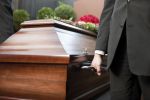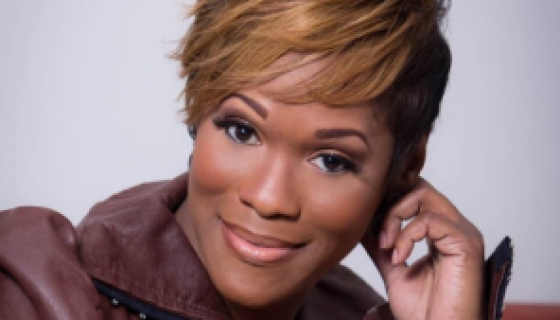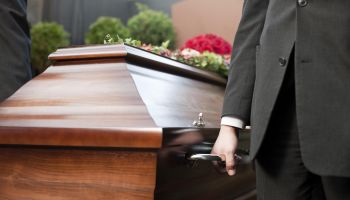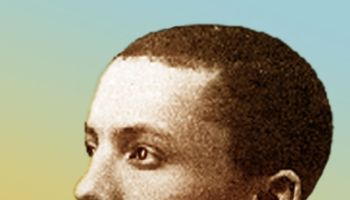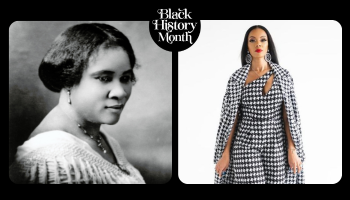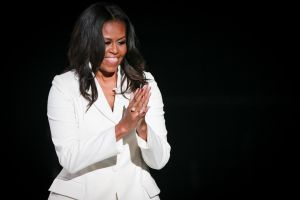
Source: Rich Fury / Forum Photos
Michelle LaVaughn Robinson Obama (born January 17, 1964) is an American writer, lawyer, and university administrator who was First Lady of the United States from 2009 to 2017. She is married to the 44th U.S. President, Barack Obama, and was the first African-American First Lady.
Raised on the South Side of Chicago, Illinois, Obama is a graduate of Princeton University and Harvard Law School. In her early legal career, she worked at the law firm Sidley Austin, where she met Barack Obama. She subsequently worked in non-profits and as the Associate Dean of Student Services at the University of Chicago and the Vice President for Community and External Affairs of the University of Chicago Medical Center. Michelle married Barack in 1992 and they have two daughters.
Obama campaigned for her husband’s presidential bid throughout 2007 and 2008, delivering a keynote address at the 2008 Democratic National Convention. She returned to speak for him at the 2012 Democratic National Convention. During the 2016 Democratic National Convention in Philadelphia, she delivered a speech in support of the Democratic presidential nominee, Hillary Clinton, a former First Lady.
As First Lady, Obama served as a role model for women, and worked as an advocate for poverty awareness, education, nutrition, physical activity and healthy eating. She supported American designers and was considered a fashion icon.
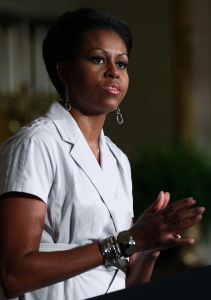
Source: Mark Wilson / Getty
Family and education
Early life and ancestry
Michelle LaVaughn Robinson was born on January 17, 1964, in Chicago, Illinois, to Fraser Robinson III (1935–1991), a city water plant employee and Democratic precinct captain, and Marian Shields Robinson (b.July 30, 1937), a secretary at Spiegel’s catalog store.[4] Her mother was a full-time homemaker until Michelle entered high school.
The Robinson and Shields families trace their roots to pre-Civil War African Americans in the American South.[3] On her father’s side, she is descended from the Gullah people of South Carolina’s Low Country region. Her paternal great-great grandfather, Jim Robinson, was born into slavery in 1850 on Friendfield Plantation, near Georgetown, South Carolina. He became a freedman at age 15 after the war. Some of Obama’s paternal family still reside in the Georgetown area. Her grandfather Fraser Robinson, Jr. built his own house in South Carolina. He and his wife LaVaughn (née Johnson) returned to the Low Country from Chicago after retirement.
Among her maternal ancestors was her great-great-great-grandmother (3xgreat-grandmother), Melvinia Shields, born into slavery in South Carolina but sold to Henry Walls Shields, who had a 200-acre farm in Clayton County, Georgia near Atlanta. Melvinia’s first son, Dolphus T. Shields, was biracial and born into slavery about 1860. Based on DNA and other evidence, in 2012 researchers said his father was likely 20-year-old Charles Marion Shields, son of Melvinia’s master. They may have had a continuing relationship, as she had two more mixed-race children and lived near Shields after emancipation, taking his surname. (Later she changed her surname.)
As was often the case, Melvinia did not talk to relatives about Dolphus’ father. Dolphus Shields with his wife Alice moved to Birmingham, Alabama after the Civil War. They were great-great-grandparents of Michelle Robinson, whose grandparents had moved to Chicago. Other of their children’s lines migrated to Cleveland, Ohio in the 20th century.
All four of Robinson’s grandparents had multiracial ancestors, reflecting the complex history of the U.S. Her extended family has said that people did not talk about the era of slavery when they were growing up. distant ancestry includes Irish, English and Native American roots. Among her contemporary extended family is rabbi Capers Funnye; born in Georgetown, South Carolina, he is the son of her grandfather Robinson’s sister and her husband, and is about 12 years older than Michelle. Funnye converted to Judaism after college. He is a paternal first cousin once-removed.
Robinson’s childhood home was on the upper floor of 7436 South Euclid Avenue in Chicago’s South Shore community area, which her parents rented from her great-aunt, who had the first floor. She was raised in what she describes as a “conventional” home, with “the mother at home, the father works, you have dinner around the table”. Her elementary school was down the street. She and her family enjoyed playing games such as Monopoly, reading, and frequently saw extended family on both sides. She played piano, learning from her great-aunt who was a piano teacher. The Robinsons attended services at nearby South Shore United Methodist Church. They used to vacation in a rustic cabin in White Cloud, Michigan. She and her 21-month older brother, Craig, skipped the second grade.
Her father suffered from multiple sclerosis, which had a profound emotional effect on her as she was growing up. She was determined to stay out of trouble and be a good student, which was what her father wanted for her. By sixth grade, Michelle joined a gifted class at Bryn Mawr Elementary School (later renamed Bouchet Academy). She attended Whitney Young High School, Chicago’s first magnet high school, established as a selective enrollment school, where she was a classmate of Jesse Jackson‘s daughter Santita. The round-trip commute from the Robinsons’ South Side home to the Near West Side, where the school was located, took three hours. Michelle recalled being fearful of how others would perceive her, but disregarded any negativity around her and used it “to fuel me, to keep me going”. She recalled facing gender discrimination growing up, saying, for example, that rather than asking her for her opinion on a given subject, people commonly tended to ask what her older brother thought. She was on the honor roll for four years, took advanced placement classes, was a member of the National Honor Society, and served as student council treasurer. She graduated in 1981 as the salutatorian of her class.
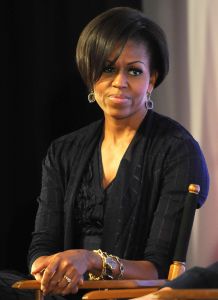
Source: Mark Sullivan / Getty
Education and early career
She was inspired to follow her brother to Princeton University, which she entered in 1981. She majored in sociology and minored in African-American studies, graduating cum laude with a Bachelor of Arts in 1985.
Robinson recalls that some of her teachers in high school tried to dissuade her from applying, and that she had been warned against “setting my sights too high”. She believed that her brother’s status as an alumnus — he graduated in 1983, before being hired as a basketball coach at Oregon State University and Brown University — may have helped her during the admission process, but she was resolved to demonstrate her own worth. She has stated that she was overwhelmed during her first year, attributing this to the fact that neither of her parents had graduated from college, and that she had never spent time on a college campus.
The mother of a white roommate reportedly tried (unsuccessfully) to get her daughter reassigned because of Michelle’s race. Robinson said that being at Princeton was the first time she became more aware of her ethnicity and, despite the willingness of her classmates and teachers to reach out to her, she still felt “like a visitor on campus”. There were also issues of economic class. “I remember being shocked”, she says, “by college students who drove BMWs. I didn’t even know parents who drove BMWs.”
While at Princeton, Robinson got involved with the Third World Center (now known as the Carl A. Fields Center), an academic and cultural group that supported minority students. She ran their day care center, which also offered after school tutoring for older children. She challenged the teaching methodology for French because she felt that it should be more conversational. As part of her requirements for graduation, she wrote a sociology thesis, entitled Princeton-Educated Blacks and the Black Community. She researched her thesis by sending a questionnaire to African-American graduates, asking that they specify when and how comfortable they were with their race prior to their enrollment at Princeton and how they felt about it when they were a student and since then. Of the 400 alumni to whom she sent the survey, fewer than 90 responded. Her findings did not support her hope that the black alumni would still identify with the African-American community, even though they had attended an elite university and had the advantages that accrue to its graduates.
Robinson pursued professional study, earning her Juris Doctor (J.D.) degree from Harvard Law School in 1988. By the time she applied for Harvard Law, biographer Bond wrote, her confidence had increased; “This time around, there was no doubt in her mind that she had earned her place”. Her faculty mentor at Harvard Law was Charles Ogletree, who has said that she had answered the question that had plagued her throughout Princeton by the time she arrived at Harvard Law: whether she would remain the product of her parents or keep the identity she had acquired at Princeton; she had concluded she could be “both brilliant and black”.
At Harvard, Robinson participated in demonstrations advocating the hiring of professors who were members of minority groups. She worked for the Harvard Legal Aid Bureau, assisting low-income tenants with housing cases. She is the third First Lady with a postgraduate degree, after her two immediate predecessors, Hillary Clinton and Laura Bush. She later said that her education gave her opportunities beyond what she had ever imagined.
Family life
Her father, Fraser C. Robinson III, died from complications from his illness in March 1991. She would later say that although he was the “hole in my heart” and “loss in my scar”, the memory of her father has motivated her each day since. Her friend Suzanne Alele died from cancer around this time as well. These losses made her think of her contributions toward society and how well she was influencing the world from her law firm, in her first job after law school. She considered this a turning point.
Robinson met Barack Obama when they were among the few African Americans at their law firm, Sidley Austin LLP (she has sometimes said only two, although others have noted that there were others in different departments). She was assigned to mentor him while he was a summer associate. Their relationship started with a business lunch and then a community organization meeting where he first impressed her.
Before meeting Obama, Michelle had told her mother she intended to focus solely on her career. The couple’s first date was to Spike Lee‘s 1989 movie Do the Right Thing Barack Obama has said that the two had an “opposites attract” scenario in their initial interest in each other, since Michelle had stability from her two-parent home while he was “adventurous”. They married on October 3, 1992. suffering a miscarriage, Michelle underwent in vitro fertilisation to conceive their daughters Malia Ann (born 1998) and Natasha (known as Sasha, born 2001).
The Obama family lived on Chicago’s South Side, where Barack taught at the University of Chicago Law School. He was elected to the state senate in 1996, and to the US Senate in 2004. They chose to keep their residence in Chicago after Barack’s election rather than to move to Washington, DC, as they felt it was better for their daughters. Throughout her husband’s 2008 campaign for US President, Michelle Obama made a “commitment to be away overnight only once a week – to campaign only two days a week and be home by the end of the second day” for their two daughters.
The Obamas’ daughters attended the University of Chicago Laboratory Schools, a private school. As a member of the school’s board, Michelle fought to maintain diversity in the school when other board members connected with the University of Chicago tried to reserve more slots for children of the university faculty. This resulted in a plan to expand the school to increase enrollment. In Washington, DC, Malia and Sasha attended Sidwell Friends School, after also considering Georgetown Day School. In 2008 Michelle said in an interview on The Ellen DeGeneres Show that they did not intend to have any more children. The Obamas received advice from past first ladies Laura Bush, Rosalynn Carter and Hillary Clinton about raising children in the White House. Marian Robinson, Michelle’s mother, moved into the White House to assist with child care.
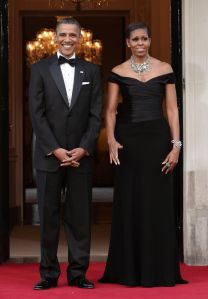
Source: WPA Pool / Getty
Religion
The Obama family attended several different Protestant churches after moving to Washington D.C. in 2009, including Shiloh Baptist Church and St. John’s Episcopal Church on Lafayette Square, known as the Presidents’ Church. At the 49th African Methodist Episcopal Church‘s general conference, Michelle Obama encouraged the attendees to advocate for political awareness, saying, “To anyone who says that church is no place to talk about these issues, you tell them there is no place better – no place better, because ultimately, these are not just political issues – they are moral issues, they’re issues that have to do with human dignity and human potential, and the future we want for our kids and our grandkids.”
Career
Following law school, Obama became an associate at the Chicago office of the law firm Sidley & Austin, where she met her future husband Barack. At the firm, she worked on marketing and intellectual property law. She continues to hold her law license, but as she no longer needs it for her work, she has kept it on a voluntary inactive status since 1993.
In 1991, she held public sector positions in the Chicago city government as an Assistant to the Mayor, and as Assistant Commissioner of Planning and Development. In 1993, she became Executive Director for the Chicago office of Public Allies, a non-profit organization encouraging young people to work on social issues in nonprofit groups and government agencies. She worked there nearly four years and set fundraising records for the organization that still stood 12 years after she left. Obama later said that she had never been happier in her life prior to working “to build Public Allies”
In 1996, Obama served as the Associate Dean of Student Services at the University of Chicago, where she developed the University’s Community Service Center. In 2002, she began working for the University of Chicago Hospitals, first as executive director for community affairs and, beginning May 2005, as Vice President for Community and External Affairs.
She continued to hold the University of Chicago Hospitals position during the primary campaign of 2008, but cut back to part-time in order to spend time with her daughters as well as work for her husband’s election. She subsequently took a leave of absence from her job.
According to the couple’s 2006 income tax return, her salary was $273,618 from the University of Chicago Hospitals, while her husband had a salary of $157,082 from the United States Senate. The Obamas’ total income was $991,296, which included $51,200 she earned as a member of the board of directors of TreeHouse Foods, and investments and royalties from his books.
Obama served as a salaried board member of TreeHouse Foods, Inc. (NYSE: THS), a major Wal-Mart supplier from shortly after her husband was seated in the Senate until she cut ties shortly after her husband announced his candidacy for the presidency; he criticized Wal-Mart labor policies at an AFL-CIO forum in Trenton, New Jersey, on May 14, 2007. She also served on the board of directors of the Chicago Council on Global Affairs.
Barack Obama political campaigns
Early campaigns
During an interview in 1996, Michelle Obama acknowledged there was a “strong possibility” her husband would begin a political career, but said she was “wary” of the process. She knew it meant their lives would be subject to scrutiny and she was intensely private.
Although she campaigned on her husband’s behalf since early in his political career by handshaking and fund-raising, she did not relish the activity at first. When she campaigned during her husband’s 2000 run for United States House of Representatives, her boss at the University of Chicago asked if there was any single thing about campaigning that she enjoyed; after some thought, she replied that visiting so many living rooms had given her some new decorating ideas. Obama opposed her husband’s run for the congressional seat, and, after his defeat, she preferred he tend to the financial needs of the family in what she deemed a more practical way.
2008 Presidential campaign
In May 2007, three months after her husband declared his presidential candidacy, Obama reduced her professional responsibilities by 80 percent to support his presidential campaign. Early in the campaign, she had limited involvement in which she traveled to political events only two days a week and rarely traveled overnight;[by early February 2008 her participation had increased significantly. She attended thirty-three events in eight days. She made several campaign appearances with Oprah Winfrey. She wrote her own stump speeches for her husband’s presidential campaign and generally spoke without notes.
During the campaign, columnist Cal Thomas on Fox News described Michelle Obama as an “Angry Black Woman“ and some web sites attempted to promote this image. Obama said: “Barack and I have been in the public eye for many years now, and we’ve developed a thick skin along the way. When you’re out campaigning, there will always be criticism. I just take it in stride, and at the end of the day, I know that it comes with the territory.”
By the time of the 2008 Democratic National Convention in August, media outlets observed that her presence on the campaign trail had grown softer than at the start of the race, focusing on soliciting concerns and empathizing with the audience rather than throwing down challenges to them, and giving interviews to shows such as The View and publications like Ladies’ Home Journal rather than appearing on news programs. The change was reflected in her fashion choices, as she wore clothes that were more informal clothes than her earlier designer pieces. Partly intended to help soften her public image, her appearance on The View was widely covered in the press.
The presidential campaign was Obama’s first exposure to the national political scene; she was considered the least famous of the candidates’ spouses. Early in the campaign, she told anecdotes about Obama family life; however, as the press began to emphasize her sarcasm, she toned it down.
New York Times op-ed columnist Maureen Dowd wrote:
I wince a bit when Michelle Obama chides her husband as a mere mortal – a comic routine that rests on the presumption that we see him as a god … But it may not be smart politics to mock him in a way that turns him from the glam JFK into the mundane Gerald Ford, toasting his own English muffin. If all Senator Obama is peddling is the Camelot mystique, why debunk this mystique?
On the first night of the 2008 Democratic National Convention, Craig Robinson introduced his younger sister.delivered her speech, during which she sought to portray herself and her family as the embodiment of the American Dream. Obama said she and her husband believe “that you work hard for what you want in life, that your word is your bond, and you do what you say you’re going to do, that you treat people with dignity and respect, even if you don’t know them, and even if you don’t agree with them.” She also emphasized loving her country, likely responding to criticism for having said that she felt ‘proud of her country for the first time’. The first statement was seen as a gaffe. Her keynote address was largely well-received and drew mostly positive reviews. Rasmussen Reports poll found that her favorability among Americans reached 55%, the highest for her.
2012 Presidential re-election campaign
Obama was considered a polarizing figure, having aroused both “sharp enmity and deep loyalty” from Americans, but she was also seen as having improved her image since 2008 when her husband first ran for the presidency. Isabel Wilkinson of The Daily Beast said that Obama’s fashion style changed over the course of the campaign to be sensitive and economical.
Prior to the first debate of the election cycle, Obama expressed confidence in her husband’s debating skills. He was later criticized for appearing detached and for looking down when addressing Romney. The consensus among uncommitted voters was that the latter ‘won’ the debate. Obama’s speech at the 2012 Democratic National Convention, the First Lady was found through a CBS News/New York Times poll conducted in September to have a 61% favorably rating with registered voters, the highest percentage she had polled since April 2009.
Obama aimed to humanize her husband by relating stories about him, attempting to appeal to female voters in swing states. Paul Harris of The Guardian said that the same tactic was being used by Ann Romney, wife of 2012 Republican candidate Mitt Romney. Polls in October showed their husbands tied at 47% for the female vote. However, Michelle Obama’s favorability ratings remained higher than Ann Romney’s at 69% to 52%. Despite Obama’s higher poll numbers, comparisons between Obama and Romney were repeatedly made by the media until the election., as Michelle Cottle of Newsweek wrote, “…nobody votes for first lady.”]
First Lady of the United States (2009–2017)
Obama advocated for her husband’s policy priorities by promoting bills that support it. She hosted a White House reception for women’s rights advocates in celebration of the enactment of the Lilly Ledbetter Fair Pay Act of 2009 Pay equity law. She supported the economic stimulus bill in visits to the United States Department of Housing and Urban Development and United States Department of Education. Some observers looked favorably upon her legislative activities, while others said that she should be less involved in politics. According to her representatives, she intended to visit all United States Cabinet-level agencies in order to get acquainted with Washington.
In 2009 Obama was named Barbara Walters‘ Most Fascinating Person of the year.
In her memoir, Becoming, Obama describes her four primary initiatives as First Lady: Let’s Move!, Reach Higher], Let Girls Learn Joining Forces. Some initiatives of First Lady Michelle Obama included advocating on behalf of military families, helping working women balance career and family, encouraging national service, and promoting the arts and arts education. Obama made supporting military families and spouses a personal mission and increasingly bonded with military families. According to her aides, stories of the sacrifice these families make moved her to tears. In April 2012, Obama and her husband were awarded the Jerald Washington Memorial Founders’ Award by the National Coalition for Homeless Veterans (NCHV).The award is the highest honor given to homeless veteran advocates.[142] Obama was again honored with the award in May 2015, accepting with Jill Biden.
In May 2014, Obama joined the campaign to bring back school girls who had been kidnapped in Nigeria. The First Lady tweeted a picture of herself holding a poster with the #bringbackourgirls campaign hashtag. writes in her book enlisting help for her initiative Let Girls Learn to produce and sing the song “This is for My Girls”.
Over the course of the Obama presidency, particularly during the second term, Michelle Obama was subject to speculation over whether she would run for the presidency herself, similarly to predecessor Hillary Clinton. A potential Michelle Obama candidacy was supported by both Samuel L. Jackson and James Clyburn. On April 6, 2009, CNN did a poll on whether she should run for the presidency in 2020, 83% of responders being opposed to the idea. A May 2015 Rasmussen poll found Obama had 22% of support to Clinton’s 56% of winning the Democratic nomination, higher than that of potential candidates Elizabeth Warren, Martin O’Malley and Bernie Sanders. Another poll from that month found 71% of Americans believed that Obama should not run for the presidency, only 14% approving. On January 14, 2016, during a town-hall meeting, President Obama was asked if the First Lady could be talked into running. He responded, “There are three things that are certain in life: death, taxes, and Michelle is not running for president. That I can tell you.” March 16, 2016, while speaking in Austin, Texas, Obama denied that she would ever run for the office, citing a desire to “impact as many people as possible in an unbiased way”. In the epilogue to Becoming, Obama writes, “I have no intention of running for office, ever,” recognizing that “politics can be a means for positive change, but this arena is just not for me.”
Let’s Move!
Obama’s predecessors Hillary Clinton and Laura Bush supported the organic movement by instructing the White House kitchens to buy organic food. Obama extended their support of healthy eating by planting the White House Kitchen Garden, an organic garden, the first White House vegetable garden since Eleanor Roosevelt served as First Lady. She also had bee hives installed on the South Lawn of the White House. The garden supplied organic produce and honey for the meals of the First Family and for state dinners and other official gatherings.
Michelle Obama said that her goal was to make this effort her legacy: “I want to leave something behind that we can say, ‘Because of this time that this person spent here, this thing has changed.’ And my hope is that that’s going to be in the area of childhood obesity.” Her 2012 book American Grown: The Story of the White House Kitchen Garden and Gardens Across America is based on her experiences with the garden and promotes healthy eating.[165] Her call for action on healthy eating was repeated by the United States Department of Defense, which has been facing an ever-expanding problem of obesity among recruits.
Several Republicans have critiqued or lampooned Obama’s initiative. In October 2014, senator Rand Paul linked to Michelle Obama’s Twitter account when announcing on the website that he was going to Dunkin’ Donuts. In January 2016, Chris Christie, Republican Governor of New Jersey and presidential candidate, criticized the First Lady’s involvement with healthy eating while he was campaigning in Iowa, arguing that she was using the government to exercise her views on eating. Obama had previously cited Christie as an example of an adult who struggled with obesity, a demographic she sought to diminish by targeting children since Let’s Move!was “working with kids when they’re young, so that they don’t have these direct challenges when they get older.” In February, Senator Ted Cruz said that he would end Obama’s health policies and return french fries to school cafeterias if his wife was First Lady.

